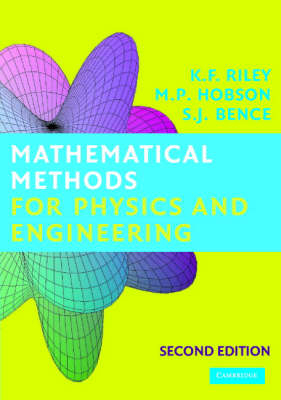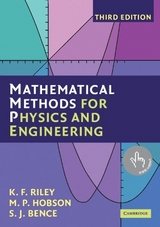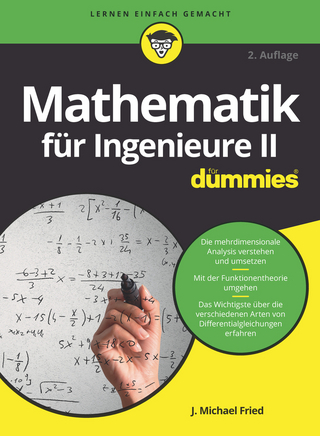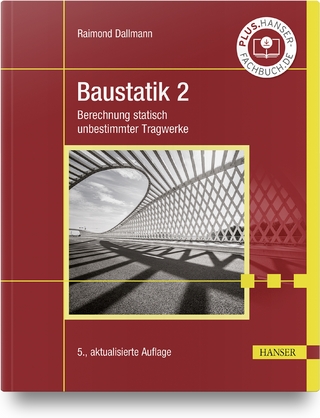
Mathematical Methods for Physics and Engineering
Cambridge University Press (Verlag)
978-0-521-89067-0 (ISBN)
- Titel erscheint in neuer Auflage
- Artikel merken
The new edition of this highly acclaimed textbook contains several major additions, including more than four hundred new exercises (with hints and answers). To match the mathematical preparation of current senior college and university entrants, the authors have included a preliminary chapter covering areas such as polynomial equations, trigonometric identities, coordinate geometry, partial fractions, binomial expansions, induction, and the proof of necessary and sufficient conditions. Elsewhere, matrix decompositions, nearly-singular matrices and non-square sets of linear equations are treated in detail. The presentation of probability has been reorganised and greatly extended, and includes all physically important distributions. New topics covered in a separate statistics chapter include estimator efficiency, distributions of samples, t- and F-tests for comparing means and variances, applications of the chi-squared distribution, and maximum likelihood and least-squares fitting. In other chapters the following topics have been added: linear recurrence relations, curvature, envelopes, curve-sketching, and more refined numerical methods.
Ken Riley read Mathematics at the University of Cambridge and proceeded to a Ph.D. there in theoretical and experimental nuclear physics. He became a Research Associate in elementary particle physics at Brookhaven, and then, having taken up a lectureship at the Cavendish Laboratory, Cambridge, continued this research at the Rutherford Laboratory and Stanford; in particular he was involved in the experimental discovery of a number of the early baryonic resonances. As well as having been Senior Tutor at Clare College, where he has taught physics and mathematics for nearly forty years, he has served on many committees concerned with teaching and examining of these subjects at all levels of tertiary and undergraduate education. He is also one of the authors of 200 Puzzling Physics Problems. Michael Hobson read Natural Sciences at the University of Cambridge, specialising in theoretical physics, and remained at the Cavendish Laboratory to complete a Ph.D. in the physics of star-formation. As a Research Fellow at Trinity Hall, Cambridge, and subsequently an Advanced Fellow of the Particle Physics and Astronomy Research Council, he developed an interest in cosmology, and in particular in the study of fluctuations in the cosmic microwave background. He was involved in the first detection of these fluctuations using a ground-based interferometer. He is currently a University Lecturer at the Cavendish Laboratory and his research interests include both theoretical and observational aspects of cosmology. He is also a Director of Studies in Natural Sciences at Trinity Hall and enjoys an active role in the teaching of undergraduate physics and mathematics. Stephen Bence obtained both his undergraduate degree in Natural Sciences and his Ph.D. in Astrophysics from the University of Cambridge. He then became a Research Associate with a special interest in star-formation processes and the structure of star-forming regions. In particular his research has concentrated on the physics of jets and outflows from young stars. He has had considerable experience of teaching mathematics and physics to undergraduate and pre-university students.
1. Preliminary algebra; 2. Preliminary calculus; 3. Complex numbers and hyperbolic functions; 4. Series and limits; 5. Partial differentiation; 6. Multiple integrals; 7. Vector algebra; 8. Matrices and vector spaces; 9. Normal modes 10. Vector calculus; 11. Line, surface and volume integrals; 12. Fourier series; 13. Integral transforms; 14. First-order ordinary differential equations; 15. Higher ordinary differential equations; 16. Series solutions of ordinary differential equations; 17. Eigenfunction methods for differential equations; 18. Partial differential equations: general and particular; 19. Partial differential equations: separation of variables and other methods; 20. Complex variables; 21. Tensors; 22. Calculus of variations; 23. Integral equations; 24. Group theory; 25. Representation theory; 26. Probability; 27. Statistics; 28. Numerical methods; Appendix; Index.
| Erscheint lt. Verlag | 15.8.2002 |
|---|---|
| Zusatzinfo | Worked examples or Exercises; 20 Tables, unspecified; 200 Line drawings, unspecified |
| Verlagsort | Cambridge |
| Sprache | englisch |
| Maße | 175 x 247 mm |
| Gewicht | 1907 g |
| Themenwelt | Mathematik / Informatik ► Mathematik ► Angewandte Mathematik |
| Naturwissenschaften ► Physik / Astronomie | |
| Technik | |
| ISBN-10 | 0-521-89067-5 / 0521890675 |
| ISBN-13 | 978-0-521-89067-0 / 9780521890670 |
| Zustand | Neuware |
| Haben Sie eine Frage zum Produkt? |
aus dem Bereich



